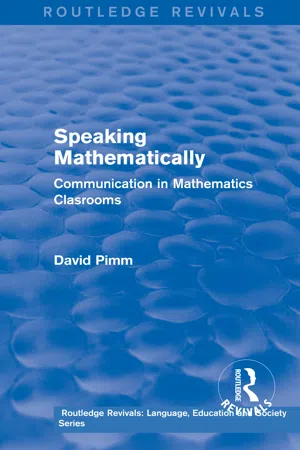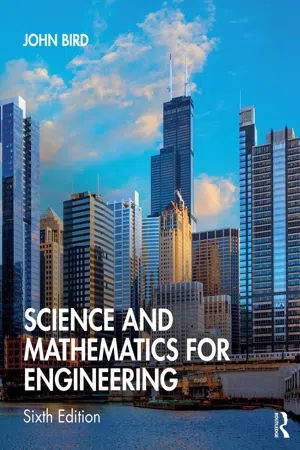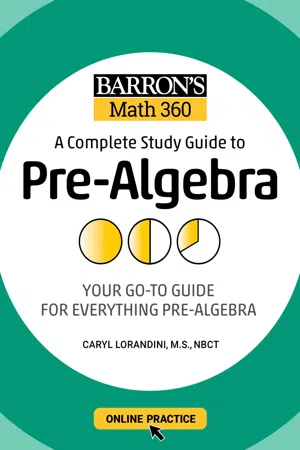Mathematics
Rewriting Formulas and Equations
Rewriting formulas and equations involves manipulating mathematical expressions to isolate a specific variable or to solve for a different variable. This process often involves using inverse operations such as addition and subtraction, multiplication and division, and exponentiation and roots to rearrange the equation in a different form while preserving its equality.
Written by Perlego with AI-assistance
Related key terms
5 Key excerpts on "Rewriting Formulas and Equations"
- eBook - ePub
- Alan J. Cann(Author)
- 2013(Publication Date)
- Wiley(Publisher)
2
Manipulating Numbers
Algebra (from the Arabic, al-jabr, ‘the reduction’) – a form of maths where symbols are used to represent numbersLEARNING OBJECTIVES:On completing this chapter, you should be able to:- understand the basic rules of algebra;
- perform simple algebraic manipulations;
- identify and manipulate fractions.
Arithmetic is concerned with the effect of operations (e.g. addition, multiplication, etc.) on specified numbers. In algebra, operations are applied to variables rather than specific numbers. Why? Here is a classic example:John is 10 years old. His father is 35 years old. After how many years will the father be twice as old as the son?You could try to find the answer by experimenting with different numbers, but this is laborious. The better way is to treat this an algebra problem and write the problem as an equation which we can then solve.Let the father be twice as old as the son in x years time. The son will then be (10 + x ) years old and the father will be (35 + x ) year old:Therefore,Simplify this by subtracting x from each side to keep the equation balanced:Simplify by subtracting 20 from each side to keep the equation balanced:2.1. Manipulating numbers
To manipulate numbers, you need to know the rules. In mathematics, this is known as the ‘Order of Operations’ – an internationally agreed set of arbitrary rules which allows mathematicians the world over to arrive at the same answers to problems:In algebra, there are two sorts of statement which you need to be able to recognize:1. A mathematical expression is a string of symbols which describes (‘expresses’) a (potential) calculation using operators (symbols indicating an operation to be performed, e.g. plus, minus, divide, etc.) and operands (symbols which the operators act on), e.g.Expressions do not contain an equal sign, but can often be simplified, that is converted to a simpler form containing fewer terms. 2. A mathematical equation contains an equal sign. The terms (groups of numbers or symbols) on both sides of the equal sign are equivalent, e.g. - eBook - ePub
Routledge Revivals: Speaking Mathematically (1987)
Communication in Mathematics Clasrooms
- David Pimm(Author)
- 2019(Publication Date)
- Routledge(Publisher)
The meta-language of arithmetic is algebra. Many, but not all, of the transformations – the laws of arithmetic – are either taught explicitly to the pupils in the meta-language, or in the form of arithmetic specializations from which the pupils are expected to extrapolate the general form. There remains the ambiguity of whether these are the laws of arithmetic or the laws of algebra.Transformations are often reversible, but are frequently applied only in a left-to-right manner and mutually-inverse pairs are perceived and described differently. For instance, if the notion of phrase is extended to include letters, thereby switching from the context of arithmetic to that of algebra itself, then:Expanding brackets:(x + a )(x + b ) →and Factoring:x2+ ax + xb + ab (This is now the surface form in algebra.)x 2 + (a + b)x + ab → (x + a)(x + b )are seen as two separate actions, and hence, transformations.The prevalent language of the teacher in describing such transformations is often purely in terms of the surface structure, thereby focusing attention on the form rather than the meaning which gives rise to the transformation.- Take it over to the other side and change the sign.
- Cross multiply.
- Move the decimal point over.
- Turn it upside down and multiply.
- Collect all the xs on one side of the equation.
- Always do to the top what you do to the bottom.
- To multiply by ten add a nought.
All of these descriptions are to do with actions on the symbols, on how to achieve grammatical utterances from other ones. They tell what should be done, with the result that there is little impetus to examine them to see why they might be helpful transformations to carry out. Mathematically interesting things can occur if they are not blindly followed on every occasion. See Brown and Walter (1983) for an exploration of one outcome of ignoring the injunction to ‘Collect all the xs on one side of the equation.’Mathematical syntactic rules are prescriptive and are consciously and deliberately taught, learned and applied at the surface level. When confronted with a student who had written∫edx, I heard myself say ‘You never have a dx - eBook - ePub
- John Bird(Author)
- 2019(Publication Date)
- Routledge(Publisher)
Chapter 6 Solving simple equationsWhy it is important to understand: Solving simple equationsIn mathematics, engineering and science, formulae are used to relate physical quantities to each other. They provide rules so that if we know the values of certain quantities, we can calculate the values of others. Equations occur in all branches of engineering. Simple equations always involve one unknown quantity which we try to find when we solve the equation. In reality, we all solve simple equations in our heads all the time without even noticing it. If, for example, you have bought two CDs, each for the same price, and a DVD, and know that you spent £25 in total and that the DVD was £11, then you actually solve the linear equation 2x + 11 = 25 to find out that the price of each CD was £7. It is probably true to say that there is no branch of engineering, physics, economics, chemistry and computer science which does not require the solution of simple equations. The ability to solve simple equations is another stepping stone on the way to having confidence to handle engineering mathematics and science.At the end of this chapter, you should be able to:- distinguish between an algebraic expression and an algebraic equation
- maintain the equality of a given equation whilst applying arithmetic operations
- solve linear equations in one unknown including those involving brackets and fractions
- form and solve linear equations involved with practical situations
- evaluate formulae by substitution of data
6.1 Introduction
3x – 4 is an example of an algebraic expression.3x – 4 = 2 is an example of an algebraic equation (i.e. it contains an ‘=’ sign).An equation is simply a statement that two expressions are equal.Hence, A = π r 2 (where A is the area of a circle of radius r )F =9 5C + 32( which relates Fahrenheit and Celsius temperatures )and y = 3x + 2 (which is the equation of a straight line graph)are all examples of equations. Science and Mathematics for Engineering. 978-0-367-20475-4, © John Bird. Published by Taylor & Francis. All rights reserved. - eBook - ePub
- Daniel Greenberg(Author)
- 2014(Publication Date)
- Research & Education Association(Publisher)
5Algebra Topics
5.1 VARIABLES AND EXPRESSIONSAn expression is a mathematical phrase that contains numbers, variables, and symbols such as +, −, ×, and ÷. An expression can contain parentheses or other symbols as well. Numbers and variables that are separated by + or − signs are called terms ; those that are part of multiplication are called factors .An example of a simple algebraic expression is just the variable x . An expression may contain two terms, such as 2a + 3b , or it can be quite complicated, involving many letters, numbers, and symbols.A variable is a term that stands for a number or quantity, but its value can change (in contrast to a letter such as e , the elementary electron charge, which is a constant). Usual letters used for variables in algebra are x , y , z , a , b , c , but they can be anything.Multiplication can be indicated by x, •, or *, or by parentheses, as in (2)(3x ), which equals 6x , or even by nothing, as in xy , which means multiply x by y .A. Simplifying Expressions
Simplifying an expression is presenting it in a simpler form, perhaps by removing parentheses or combining some terms.5.1Problem 1: Which expression is greater: 5 − (8) or −(28)?A) 5 − (8) is greater.B) 5(−8) is greater.C) The expressions are equal in value.D) Both expressions equal −3.STRATEGY
Remove parentheses; then simplify.THINK
• Write the expression. Insert signs to give every term a sign.• Resolve signs using simple rules.• Remove parentheses and simplify. −3 is greater than −40, so 5 − (8) is greater. The correct answer choice is (A).B. Properties
The basic properties of expressions are called the associative, commutative, and distributive properties. These properties allow us to simplify expressions.• Commutative - Caryl Lorandini(Author)
- 2021(Publication Date)
- Barrons Educational Services(Publisher)
9SOLVING EQUATIONS
WHAT YOU WILL LEARN
•How to understand solving an equation as a process of answering a question: which values from a specified set, if any, make the equation true •How to use inverse operations for solving one-variable equations •How to use substitution to determine whether a given number in a specified set makes an equation true •How to write equations to solve problems by reasoning about the quantities •How to solve word problems leading to equationsSECTIONS IN THIS CHAPTER•How Do We Solve a One-Step Equation?•How Do We Solve a Two-Step Equation?•How Can Combining Like Terms Help Us?•How Can the Distributive Property Help Us?•How Can We Solve Multi-Step Equations?•How Can We Write an Equation to Solve Problems Algebraically?DEFINITIONS
EquationA mathematical sentence stating that two expressions are equal.SolutionThe value or values that make an equation, inequality, or open sentence true.9.1 How Do We Solve a One-Step Equation?
We are going to use tiles to represent equations.The above model represents x + 2 = 7.x is represented by the rectangle.2 is represented by the small squares on the left side of the equation. 7 is represented by the small squares on the right side of the equation.We want to find the value of the x. We can tell by inspection the rectangle is worth 5 small squares. This can also be done by removing two small squares from each side.The most important rule to remember with equations is keeping it equal. You have to “do the same thing to both sides.”Another way to look at it is to think of operations. The equation is showing addition. We want to “undo” the equation. We need the inverse of addition. We need subtraction. If we subtract 2 from both sides, we get the solution of x = 5 as well.Let’s look at another equation.2x is represented by the 2 rectangles.–8 is represented by the small squares on the right side of the equation.We want to find the value of the x
Index pages curate the most relevant extracts from our library of academic textbooks. They’ve been created using an in-house natural language model (NLM), each adding context and meaning to key research topics.




